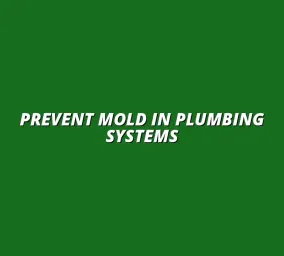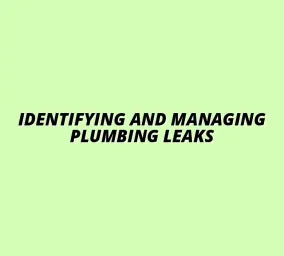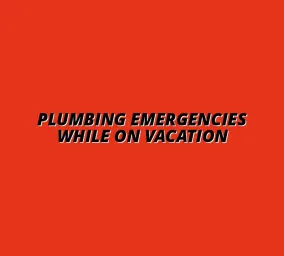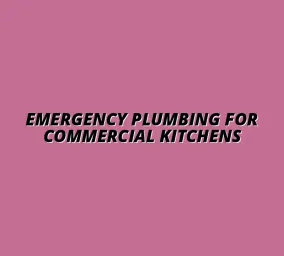Sump Pump Maintenance Tips
Understanding the Importance of Sump Pump Maintenance for Flood Prevention
Maintaining a sump pump is essential for preventing basement flooding and safeguarding your home. Sump pumps operate quietly in the background, yet their role is crucial in managing excess water. When they fail, the consequences can be severe, leading to costly repairs and damage to your belongings. A sump pump failure during a storm can be particularly devastating.
Regular maintenance helps keep your sump pump in top condition, ensuring it operates effectively when you need it most. Think of it as giving your sump pump a little TLC! Over time, dirt, debris, and wear can impair its function, so staying proactive is key to avoiding a flooding nightmare. Just like you maintain other crucial home systems, such as your kitchen plumbing and bathroom plumbing, your sump pump requires attention.
The Role of Sump Pumps in Basement Water Management
Sump pumps are designed to remove excess water that accumulates in basements, especially during heavy rainfall or snowmelt. They collect water in a sump basin and pump it away from your home. This can prevent water damage, mold growth, and foundation issues.
They come in various types, including submersible and pedestal pumps. Each type has its strengths, but all serve the main purpose of keeping your basement dry. A working sump pump is a homeowner's best friend when it comes to flood prevention!
- Submersible Pumps: These are submerged in water and are generally quieter.
- Pit vs. Non-Pit Pumps: Pit pumps are installed in a sump pit, while non-pit pumps are installed directly on the basement floor.
- Primary vs. Backup Pumps: Primary pumps handle regular water levels, while backup pumps kick in during power outages or high water levels.
Common Causes of Basement Flooding and How Sump Pumps Help
Basement flooding can occur due to a variety of factors, including heavy rainfall, melting snow, or groundwater seepage. Understanding these causes is crucial for taking preventative measures. If you ignore the potential for flooding, you might find yourself facing significant cleanup and repair costs.
Sump pumps play a vital role in combating these issues. By actively pumping out excess water, they minimize the risk of flooding. They are particularly useful in areas prone to heavy rains or where the water table is high. Remember that proactive plumbing maintenance, as described in this guide to maintaining your plumbing year-round, can significantly reduce the risk of emergencies.
- Heavy Rain: Excessive rainfall can overwhelm drainage systems.
- Groundwater Seepage: Water can seep through walls or floors if the soil surrounding your home becomes saturated.
- Clogged Gutters and Downspouts: Poor drainage from gutters can lead to water pooling near your foundation.
Essential Maintenance Practices for Optimal Sump Pump Performance
To ensure that your sump pump operates optimally, regular maintenance is a must! Taking a few simple steps can make a significant difference in your pump's performance. Most homeowners often overlook maintenance, but it doesn't have to be complicated or time-consuming!
From visual inspections to cleaning and testing, each practice plays a role in keeping your sump pump ready for action. By being proactive, you not only enhance the longevity of your pump but also provide peace of mind that your basement is protected. Regular maintenance is just as important for your water heater to prevent costly repairs down the line.
Regular Visual Inspections: Identifying Potential Issues
Conducting visual inspections is one of the simplest ways to maintain your sump pump. Look for any signs of wear, rust, or build-up around the pump and pit. Small issues can often escalate into bigger problems if not addressed early.
During your inspections, make sure to check the floating switch, which controls the pump's operation. If it gets stuck or doesn’t move freely, your pump may not work when needed. A few routine checks can save you from unexpected flooding! Addressing issues promptly can prevent more extensive and costly problems, as seen in the case of plumbing issues in Birmingham.
- Inspect for Debris: Remove any dirt or leaves that may obstruct the pump.
- Check for Rust or Damage: Look closely at the pump casing for any signs of corrosion.
- Test the Float Switch: Ensure it moves up and down without obstruction.
Checking the Power Source and Float Switch Functionality
It's essential to ensure your sump pump has a reliable power source. If the power goes out during a storm, your pump won't be able to function. This is particularly important if your home is in a flood-prone area.
In addition to checking the power source, verify the float switch's operation. This component controls when your sump pump turns on and off. If it’s not working properly, your system may not activate when water levels rise.
Examining the Discharge Pipe and its Position
The discharge pipe plays a critical role in directing water away from your home. Regularly check that it’s free from clogs and that the water is being expelled effectively. If the discharge pipe is blocked or improperly positioned, water may flow back into your basement. Preventing frozen pipes is crucial in cold climates; learn how at this link.
Additionally, ensure that the discharge pipe slopes downward away from your house. This slope helps maintain proper drainage and prevents water from pooling near your foundation.
Additional Tips and Best Practices for Sump Pump Longevity
Taking care of your sump pump doesn’t just help in preventing floods; it also extends the life of the pump itself. By following a few additional tips and best practices, you can ensure that your sump pump is always ready to handle unexpected water issues. Remember, a well-maintained sump pump can save you time, money, and stress in the long run!
One of the key factors in sump pump longevity is choosing the right model for your specific needs. Different basements have different challenges, and the right pump can make all the difference in efficiency and reliability.
Choosing the Right Sump Pump for Your Basement Needs
When selecting a sump pump, consider the following factors to find the perfect fit for your basement:
- Capacity: Make sure the pump can handle the volume of water in your basement.
- Type: Decide between a submersible pump or a pedestal pump based on your space and needs.
- Horsepower: A higher horsepower rating usually means more powerful pumping ability.
- Quality: Look for reputable brands known for durability and efficiency.
Finally, consider consulting with a professional to ensure you choose the right pump that suits your specific basement needs. It’s always better to be safe than sorry!
Installing Sump Pump Accessories for Enhanced Protection
To further protect your basement from flooding, you might want to consider adding some sump pump accessories. These additions can help monitor performance and ensure your pump is functioning correctly.
- Check valves: Prevent water from flowing back into the sump pit.
- Alarms: Notify you if the water level is too high or if the pump fails.
- Battery backup systems: Keep your pump running during power outages.
- Water level indicators: Help you keep track of water levels in the sump pit.
By equipping your sump pump with these accessories, you can take additional steps to prevent flooding and enhance your basement's protection!
Final Thoughts on Preventing Basement Flooding with Proper Sump Pump Care
Maintaining your sump pump is crucial in preventing basement flooding. Throughout this article, we've covered essential maintenance practices that can significantly improve your pump's performance. It’s all about being proactive, and regular care can save you from a lot of headaches in the future.
As a homeowner, it's important to make maintenance a regular habit. Just like you check your smoke detectors or change your air filters, sump pump care should be on that list too!
Recap of Key Maintenance Steps for Sump Pumps
Here’s a quick recap of the key maintenance steps you should follow regularly:
- Perform visual inspections.
- Check the power source and float switch.
- Clean and test your pump.
- Inspect the backup system and alarms.
Following these steps can help keep your sump pump in top shape and ready for action!
Encouraging Regular Maintenance as a Habit for Homeowners
Regular maintenance shouldn’t feel like a chore. Instead, think of it as a way to protect your home and family. Forming a maintenance routine can be easy—maybe set a reminder on your calendar!
Remember, investing a little time in your sump pump today can save you from costly repairs and damage tomorrow. It’s all about being proactive!
Resources for Professional Help and Further Learning
If you're ever unsure about how to maintain your sump pump or if you suspect it needs repairs, don’t hesitate to reach out to professionals. There are many resources available:
- Local plumbing services.
- Home improvement stores that offer workshops.
- Online forums and communities for homeowners.
Taking advantage of these resources can help you stay informed and ensure your sump pump is always in great condition!






